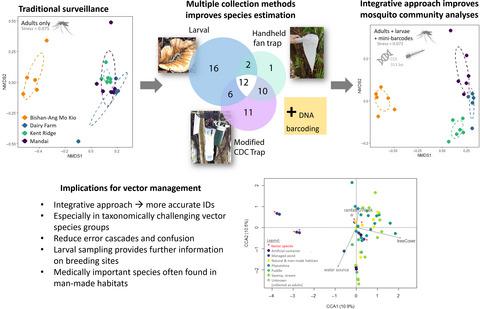当前位置:
X-MOL 学术
›
J. Appl. Ecol.
›
论文详情
Our official English website, www.x-mol.net, welcomes your feedback! (Note: you will need to create a separate account there.)
Morphology and mini-barcodes: The inclusion of larval sampling and NGS-based barcoding improves robustness of ecological analyses of mosquito communities
Journal of Applied Ecology ( IF 5.7 ) Pub Date : 2021-07-08 , DOI: 10.1111/1365-2664.13966 Huiqing Yeo 1 , Tze Xuan Yeoh 1 , Huicong Ding 1 , Theodore Tze Ming Lee 2 , Nalini Puniamoorthy 1
中文翻译:

形态学和迷你条形码:包含幼虫采样和基于 NGS 的条形码提高了蚊子群落生态分析的稳健性
更新日期:2021-07-08
Journal of Applied Ecology ( IF 5.7 ) Pub Date : 2021-07-08 , DOI: 10.1111/1365-2664.13966 Huiqing Yeo 1 , Tze Xuan Yeoh 1 , Huicong Ding 1 , Theodore Tze Ming Lee 2 , Nalini Puniamoorthy 1
Affiliation

|
- A significant proportion of vector-borne diseases are transmitted by blood-sucking dipterans, including mosquitoes. Understanding transmission risks requires accurate identification of species across heterogeneous habitats, but many cryptic and polymorphic species are overlooked when using morphological identification. Estimates of mosquito diversity are typically based on adult female trapping methods which tend to target host-seeking species and may represent a biased snapshot of community structure. Unfortunately, diversity estimates based on larval data are rarely included in mosquito ecological analyses.
- We carried out adult and larval sampling over 6 months in Singapore using an integrative approach of morphological identification and molecular delineation with mini-barcodes (313 bp) generated on a Next-Generation Sequencing platform to obtain species estimates. We collected 3,201 mosquitoes across 58 species (14 genera). Notably, 16 species were collected only through larval sampling and 22 species were only resolved using mini-barcodes. Of the latter, we identified three morphologically similar species groups and documented several intraspecific polymorphisms.
- We compared adult-only data against a full dataset (adult + larval + mini-barcode). The species accumulation curves reached an asymptote for all but one site when using the latter and non-metric multidimensional scaling (NMDS) revealed that mosquito communities were only well separated when using the full dataset. Overall, the full dataset reflects a more defined and accurate community structure across all sites. We find that many mosquito species are niche-specific and several species were generally influenced by tree cover, rainfall and presence of large water bodies.
- Synthesis and applications. We report the first successful use of mini-barcodes on mosquitoes and demonstrate its utility in delineating multiple challenging species groups. We recommend the use of both morphological and molecular identification methods for ecological studies and vector surveillance. Misidentification in species estimation, especially for medically relevant insect groups, can lead to conflicting reports and slows down vector control efforts. We provide evidence that varying sampling techniques, particularly of the larval stages for holometabolous insects, is important in generating a robust dataset for downstream analyses. Together with DNA barcoding, this integrative approach helps to minimise error cascades when designing management strategies.
中文翻译:

形态学和迷你条形码:包含幼虫采样和基于 NGS 的条形码提高了蚊子群落生态分析的稳健性
- 很大一部分病媒传播疾病是通过吸血双翅目昆虫传播的,包括蚊子。了解传播风险需要跨异质栖息地准确识别物种,但在使用形态学识别时会忽略许多隐秘和多态的物种。蚊子多样性的估计通常基于成年雌性诱捕方法,这些方法往往针对寻找宿主的物种,并且可能代表群落结构的有偏见的快照。不幸的是,蚊子生态分析很少包括基于幼虫数据的多样性估计。
- 我们在新加坡进行了超过 6 个月的成虫和幼虫采样,使用形态学鉴定和分子描绘的综合方法,以及在下一代测序平台上生成的迷你条形码 (313 bp),以获得物种估计。我们收集了 58 个物种(14 个属)的 3,201 只蚊子。值得注意的是,仅通过幼虫采样收集了 16 个物种,仅使用迷你条形码解析了 22 个物种。在后者中,我们确定了三个形态相似的物种组并记录了几种种内多态性。
- 我们将成人数据与完整数据集(成人 + 幼虫 + 迷你条形码)进行了比较。当使用后者和非度量多维标度 (NMDS) 时,除了一个站点外,所有站点的物种积累曲线都达到了渐近线,并且非度量多维缩放 (NMDS) 显示蚊子群落只有在使用完整数据集时才能很好地分离。总的来说,完整的数据集反映了所有站点的更明确和准确的社区结构。我们发现许多蚊子物种是特定于生态位的,并且一些物种通常受到树木覆盖、降雨和大型水体存在的影响。
- 合成与应用。我们报告了小型条码在蚊子上的首次成功使用,并证明了其在描绘多个具有挑战性的物种组方面的效用。我们建议使用形态学和分子鉴定方法进行生态研究和媒介监测。物种估计中的错误识别,特别是对于医学相关的昆虫群体,可能导致相互矛盾的报告并减缓病媒控制工作。我们提供的证据表明,不同的采样技术,特别是全代谢昆虫的幼虫阶段,对于为下游分析生成强大的数据集很重要。与 DNA 条形码一起,这种综合方法有助于在设计管理策略时最大限度地减少错误级联。



























 京公网安备 11010802027423号
京公网安备 11010802027423号